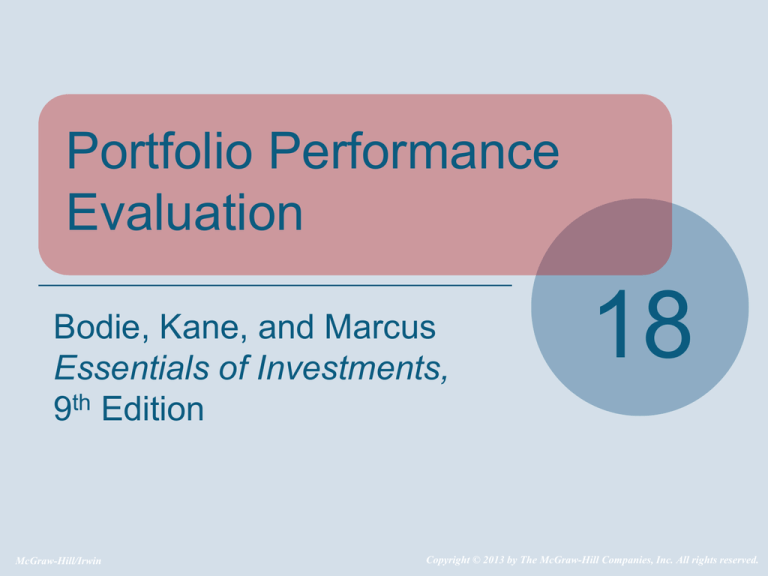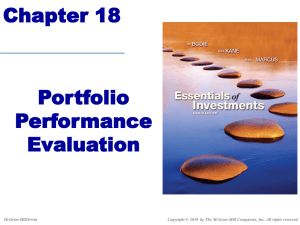
Portfolio Performance
Evaluation
Bodie, Kane, and Marcus
Essentials of Investments,
9th Edition
McGraw-Hill/Irwin
18
Copyright © 2013 by The McGraw-Hill Companies, Inc. All rights reserved.
18.1 Investment Clients, Service Providers, Objectives of
Performance Evaluation
• Passive Management
• Diversified portfolio with no security mispricing
identification
• Cash
• Virtually risk-free money market securities
• Active Management
• Forecasting broad markets and/or identifying
mispriced securities to achieve higher returns
• Market Timing
• Relative performance drives fund movement between
risky portfolio and cash
18-2
Figure 18.1 Universe Comparison
18-3
18.1 Investment Clients, Service Providers, Objectives of
Performance Evaluation
• Comparison Universe
• Set of portfolio managers with similar
investment styles used to assess relative
performance
18-4
18.1 Investment Clients, Service Providers, Objectives of
Performance Evaluation
•
18-5
18.1 Investment Clients, Service Providers, Objectives of
Performance Evaluation
•
18-6
Table 18.1 Performance of Two Managed Portfolios
18-7
18.1 Investment Clients, Service Providers, Objectives of
Performance Evaluation
•
18-8
18.1 Investment Clients, Service Providers, Objectives of
Performance Evaluation
•
18-9
Figure 18.2 M2 of Portfolio
18-10
18.1 Investment Clients, Service Providers, Objectives of
Performance Evaluation
•
18-11
18.1 Investment Clients, Service Providers, Objectives of
Performance Evaluation
• Information Ratio
• Ratio of alpha to standard deviation of
diversifiable risk
18-12
18.1 Investment Clients, Service Providers, Objectives of
Performance Evaluation
•
18-13
18.1 Investment Clients, Service Providers, Objectives of
Performance Evaluation
• Alpha Capture and Transport
• Alpha transport
• Establishing alpha while using index products
to both hedge market exposure and establish
exposure to desired sectors
• Alpha capture
• Construction of positive-alpha portfolio with
systematic risk hedged away
18-14
Table 18.2 Alpha Capture/Transfer, Healthcare Sector
*If P ’s alpha is negative, then reverse the sign of wP and adjust the signs of wM and wF.
18-15
18.1 Investment Clients, Service Providers, Objectives of
Performance Evaluation
•
18-16
18.2 Style Analysis
• Complex method of performance
evaluation introduced by William Sharpe
• Recent studies of mutual fund performance
show > 90% of return variation can be
explained by funds’ allocations to T-bills,
stocks, and bonds
18-17
Table 18.3 Sharpe’s Style Portfolios for Magellan Fund
*Regressions are constrained to have nonnegative coefficients and to have
coefficients that sum to 100%.
18-18
Figure 18.3 Fidelity Magellan Fund Cumulative Return Difference
versus Style Benchmark
18-19
Figure 18.4 Fidelity Magellan Fund Cumulative Return
Difference versus S&P 500
18-20
Figure 18.5 Average Tracking Error, 636 Mutual Funds, 85-89
18-21
18.3 Morningstar’s Risk-Adjusted Rating
• Company peer groups established based
on Morningstar style definitions
• Risk-adjusted performance ranked; then
stars assigned according to table
Percentile
Stars
0-10
1
10-32.5
2
32.5-67.5
3
67.5-90
4
90-100
5
18-22
Figure 18.6 Rankings Based on Morningstar’s Category
RARs and Excess Return Sharpe Ratios
18-23
18.4 Risk Adjustments with Changing Portfolio Composition
• Problems with Performance Measures
• Assume fund maintains constant level of risk
• Particularly problematic for funds engaging in
active asset allocation
• In large universe of funds, some will have
abnormal performance each period by chance
• Survivorship bias
• Upward bias in average fund performance
due to failure to account for failed funds over
sample period
18-24
Figure 18.7 Portfolio Returns
18-25
18.5 Performance Attribution Procedures
• Decomposing overall performance into
components
• Determined by specific portfolio choices
• Broad asset allocation among types of
securities
• Industry weighting in equity portfolio
• Security choice
• Timing
18-26
Table 18.4 Performance of Managed Portfolio
• Bogey
• Benchmark portfolio comprised of three indexes with given
weights
• Bogey return represents return on unmanaged portfolio
• Weights represent standard portfolio for typical risk
tolerance of given type of client or typical fund in category
18-27
Table 18.5 Performance Attribution
18-28
Table 18.6 Sector Allocation within Equity Market
18-29
Table 18.7 Portfolio Attribution: Summary
18-30
18.6 Market Timing
• Adjust asset allocation for movements in
market
• Shift between stocks and money market
instruments or bonds
• Behaves like an option if one has perfect ability
to forecast
• Little evidence of market-timing ability
18-31
Market Timing
• With Imperfect Ability to Forecast
• Takes long time horizon to judge ability
• Judge proportions of correct calls
• Bull market and bear market calls
18-32
Figure 18.8 RoR of Perfect Market Timer
18-33
Table 18.8 Performance of Cash, Stocks, and Perfect
Timing Strategies
18-34
Figure 18.9A Characteristic Lines
18-35
Figure 18.9B Characteristic Lines
18-36









